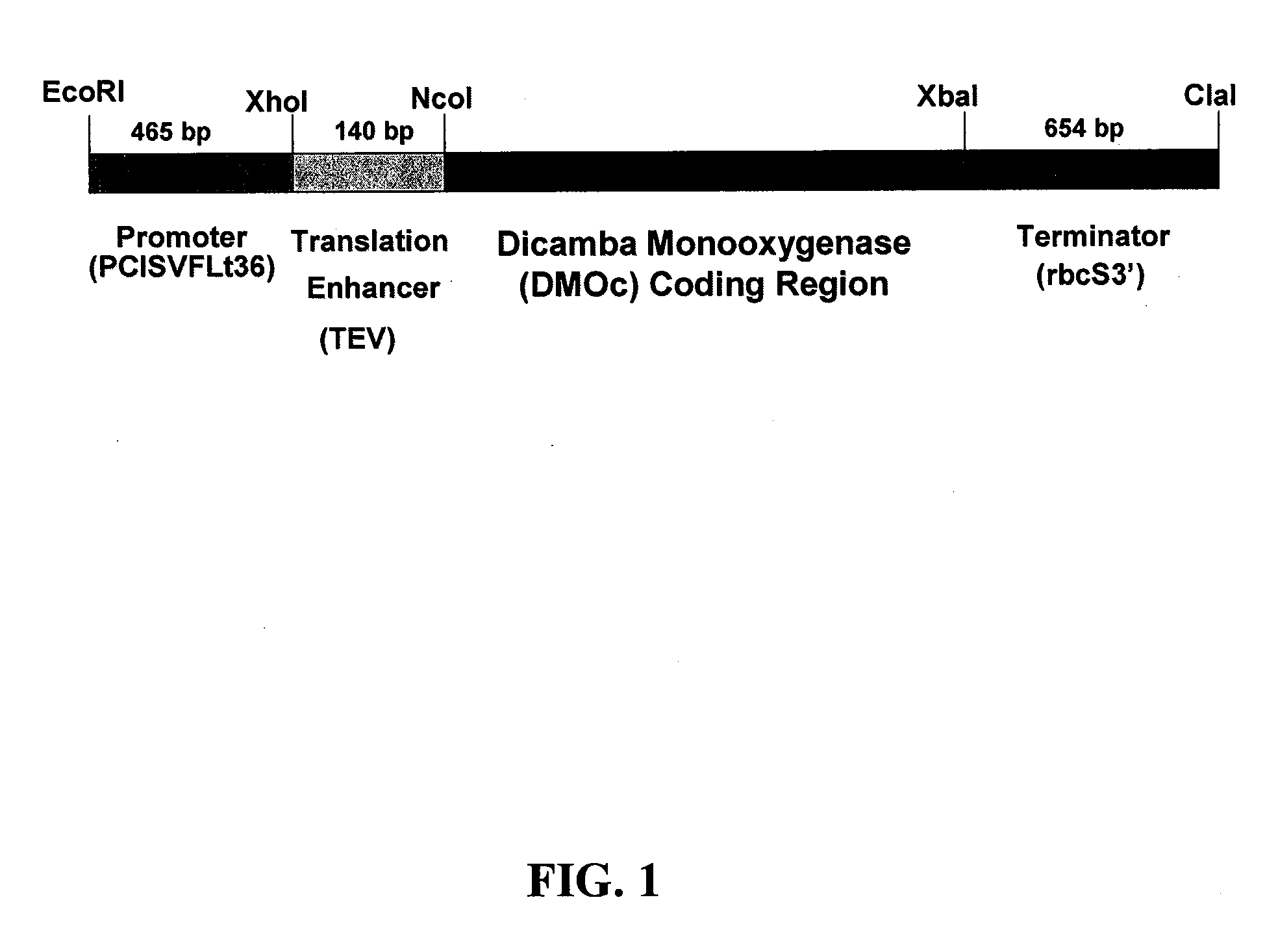Modified dmo enzyme and methods of its use
a technology of dicamba monooxygenase and dicamba monooxygenase, which is applied in the field of biotechnology, can solve the problems of dicamba monooxygenase injuring many commercial users, gaps in the spectrum of weed control and treatment options, etc., and achieve the effect of controlling weed growth
- Summary
- Abstract
- Description
- Claims
- Application Information
AI Technical Summary
Benefits of technology
Problems solved by technology
Method used
Image
Examples
example 1
Vector Construction for Genetically Engineered DMO Gene
[0081] The DMOc variant coding sequence was initially generated by PCR amplification from a DMOw template. In this amplification, the coding region of DMOw was amplified from the plasmid pPLH1, which contained the DMOw gene as a 3.5 kbp Xho I / Sst I fragment of P. maltophilia, strain DI-6, DNA. For DNA amplification, a 5′ primer was employed that inserted a Nco I restriction site near the 5′ end of the PCR product and a codon for alanine immediately following the ATG initiation codon and a 3′ primer that created an Xba I restriction site at the 3′ end of the PCR product (procedural details provided below). The 112W to 112C change was subsequently identified by nucleic acid sequencing.
[0082] For creation of the plant transformation vector, the DMOc gene was inserted using Nco I and Xba I sites added to the 5′ and 3′ ends, respectively, of the coding region into the pRTL2 vector (Carrington and Freed, 1990) thereby fusing the cod...
example 2
Production and Analysis of Transgenic Plants
[0085] Tobacco, tomato, soybeans and Arabidopsis were used for transgenic expression of the genetically engineered DMOc gene and confirmation of dicamba tolerance in plants expressing the gene. The DMOc coding sequence in binary vector pKLP36 was introduced into A. tumefaciens strain C58C1 containing the disarmed Ti plasmid pMP90 (Koncz and Schell, 1986) by triparental mating (Ditta 1980). The resultant transconjugants were used for tobacco (cv Xanthi) and tomato (cv Rutgers) transformation using the leaf disc protocol described by Horsch et al. (Horsch 1985). Arabidopsis thaliana was transformed by the floral dip technique (Clough and Bent, 1998). Transformation of soybean varieties Thorne and NE-3001 was carried out by cotyledonary-node Agrobacterium-mediated transformation system (Zhang et al., 1999).
[0086]Agrobacterium-mediated gene transfer of the DMOc gene to the nuclear genome of tobacco plants yielded several independently derive...
example 3
Overexpression, Purification and Comparison of DMOw and DMOc Enzymatic Properties
[0092] A. Cloning and Overexpression
[0093] The wild type (DMOw) and variant (DMOc) DMO coding sequences were cloned from plasmids pMON95900DMO (DMOw) and pMON58499DMO (DMOc) into vector pET28b (Novagen, San Diego, Calif.) and transformed into Escherichia coli BL21 cells (Novagen, San Diego, Calif.). Cells were grown in 1 liter of Luria-Bertani broth at 37° C. to an absorbance at 600 nm of 0.4 to 0.6. Protein expression was induced by adding 50 μM Fe(NH4)SO4, 100 μM Na2S, and 1 mM isopropyl-beta-thiogalac-topyranoside (IPTG) and the cells were switched to 15° C. After 48-72 hours at 15° C., the cells were harvested by centrifugation at 10000×g for 20 minutes. For further usage the cells were stored at −20° C.
[0094] The yield of protein expression in E. coli for DMOw and DMOc was different. While the DMOw yield was about 100 to 150 mg of pure protein per liter of LB medium, the DMOc yield was 10 fold l...
PUM
| Property | Measurement | Unit |
|---|---|---|
| Fraction | aaaaa | aaaaa |
Abstract
Description
Claims
Application Information
 Login to View More
Login to View More - R&D
- Intellectual Property
- Life Sciences
- Materials
- Tech Scout
- Unparalleled Data Quality
- Higher Quality Content
- 60% Fewer Hallucinations
Browse by: Latest US Patents, China's latest patents, Technical Efficacy Thesaurus, Application Domain, Technology Topic, Popular Technical Reports.
© 2025 PatSnap. All rights reserved.Legal|Privacy policy|Modern Slavery Act Transparency Statement|Sitemap|About US| Contact US: help@patsnap.com



